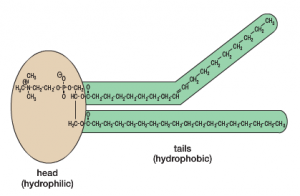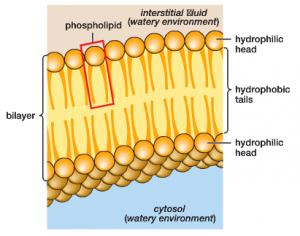Phospholipid Bilayer
Plasma Membrane
The structure and function of the plasma membrane is consistent amongst all forms of life. The plasma membrane serves to separate the interior environment of the cell from the exterior and consists of a double layer of lipids called the phospholipid bilayer. In this unit, we will explore the structure and function of the phospholipid bilayer.

The plasma membrane serves to separate the interior environment of the cell from the exterior and consists of a double layer of lipids called the phospholipid bilayer. This physical barrier manages the transport of materials into and out of the cell by utilizing a group of proteins that are embedded directly into the membrane. These membrane proteins typically make up more than half the weight of the plasma membrane.
The phospholipid bilayer and its associated proteins together act as a sophisticated filter that is selectively permeable, controlling which materials enter and leave the cell.
The plasma membrane performs the following critical functions for the cell:
- Selectively segregate the cell’s contents from its surrounding environment
- Selectively segregate contents of organelles from the surrounding cytoplasm
- Regulate exchange of substances between the cell and the external environment, or between organelles and the surrounding cytoplasm
- Facilitate communication between cells in a multicellular organism
- Create attachments within and between cells
- Regulate many biochemical reactions
-
Fluid Mosaic
Membranes are also considered to be a ‘fluid mosaic’. Their ‘fluid’ nature is due to the ability of the various phospholipids present in the bilayer to move freely amongst each other within the plane of the membrane. They are also considered to be a ‘mosaic’ since they also contain an abundance of proteins which serve several important functions.
Recall from our earlier discussion of the special class of lipids called ‘phospholipids’, these unique molecules consist of hydrophobic fatty acid tails joined to a hydrophilic head region which contains a charged phosphate group.

The behavior of these molecules, when mixed with water, is such that they will spontaneously assemble into structures where the fatty acid tails orient toward each other, leaving the hydrophilic head region to point outward to interact with the water molecules.
Summary
The plasma membrane performs the following critical functions for the cell:
- Selectively segregate the cell’s contents from its surrounding environment
- Selectively segregate contents of organelles from the surrounding cytoplasm
- Regulate exchange of substances between the cell and the external environment, or between organelles and the surrounding cytoplasm
- Facilitate communication between cells in a multicellular organism
- Create attachments within and between cells
- Regulate many biochemical reactions